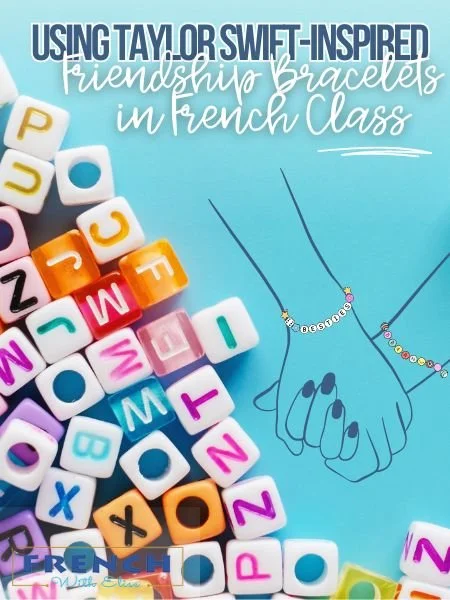Crafting Community: Organizing a Taylor Swift Friendship Bracelet Swap in Your French Class
Welcome, French educators and Taylor Swift enthusiasts! Today, we’re diving into a creative classroom activity that combines the joys of crafting with the enrichment of language learning. Hosting a Taylor Swift-themed friendship bracelet swap in your French class is not just a fun way to engage your students, but it also provides ample opportunities to build vocabulary, practice speaking, and foster a strong community spirit. Here’s your step-by-step guide to organizing this melodious event.
Step 1: Introducing Friendship Values
Begin your lesson with a discussion about friendship. Introduce key vocabulary related to friendship values in French, such as loyalty (loyauté), trust (confiance), support (soutien), and kindness (gentillesse).
For French immersion students, engage them in a deeper discussion about the nuances of these friendship values in French culture. Discuss how these values might manifest differently in French-speaking societies compared to their own, encouraging critical thinking and cultural empathy.
Step 2: Connection to Taylor Swift’s Songs
Taylor Swift’s songs often touch on themes of friendship, support, and personal growth. Have students choose a song that they feel represents a particular friendship value well. They can discuss in small groups how these themes are expressed in the song and prepare to share how it relates to the bracelet they will create.
Check out this cool blog post: 35 Best Taylor Swift Friendship Quotes from Song Lyrics.
Or/And: 7 Best Taylor Swift Songs about Friendship and Betrayal.
Step 3: Writing the Note in French, of Course
Instruct students to write a brief note in French to accompany their bracelet. In the note, they should explain which friendship value their bracelet represents and why they chose that particular value. Encourage them to link this value to the Taylor Swift song they discussed, explaining how the song’s lyrics support the theme of their bracelet. This exercise will help them practice their descriptive and explanatory skills in French.
For instance, a student might write: "J'ai choisi la couleur bleue pour représenter la confiance, comme dans la chanson 'You Belong With Me' de Taylor Swift, où elle parle de se sentir comprise et acceptée." (I chose the color blue to represent trust, as in Taylor Swift's song 'You Belong With Me,' where she talks about feeling understood and accepted.)
Step 4: The Exchange
During the bracelet exchange, have each student read their note aloud to the class before handing their bracelet to the recipient. This not only practices French reading and speaking skills but also lets students share personal insights and meanings behind their creations.
To ensure inclusivity and that no student is left out during the bracelet swap, consider implementing a structured and randomized exchange process:
Modified Step 4: Organized Exchange
During the bracelet-making session, each student is assigned a number or a specific symbol that is kept confidential. They then create their bracelet with this identifier in mind. Once all bracelets are completed, collect them and mix them up in a central basket or box.
As each student's number or symbol is called (perhaps by drawing from another basket), they come up to choose a bracelet from the collection. This method ensures that every student receives a bracelet, and it also adds an element of surprise to see which bracelet they will select. This approach helps eliminate any biases or preferences in the selection process, ensuring a fair distribution where everyone is equally included and valued.
Additionally, to create an atmosphere of mutual respect and anticipation, you can have students present the bracelet they picked, read the accompanying note aloud, and express a thank you in French to their anonymous creator. This process not only practices French but also reinforces the values of gratitude and appreciation within the classroom community.
Step 5: Reflective Discussion in French Class
After the swap, facilitate a class discussion about the different values discussed and how students feel they connect with those values personally. This could be a speaking activity or a written reflection, which would provide further practice in expressing opinions and feelings in French.
This bracelet-making activity serves multiple educational purposes: it’s a practical application of French vocabulary and grammar, an exploration of cultural expressions through music, and a meaningful examination of personal and shared values. Through such activities, students not only learn a language but also how to express deeper thoughts and emotions in French, enhancing both their linguistic and interpersonal skills.

